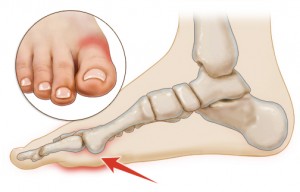Turf Toe: symptoms, treatments & prevention

What is turf toe?
Turf toe is essentially a sprain or hyperextension of the primary joint in the big toe. It’s often related to how the toes bend firmly against the ground while the foot falls forward. If the ground isn’t shock absorbent, such as with pavement or turf, trauma and damage can occur. Turf toe is sometimes referred to as a jammed or sprained toe, though the condition is more specific than that.
More specifically, turf toe is an injury to the main joint of your big toe, known as the metatarsophalangeal joint (MTP), and the plantar complex in the ball of the foot. Located at the base of your big toe, the plantar complex consists of the MTP joint as well as the tissues, ligaments, and tendons that connect the metatarsal bone in your foot to your toe bone. While this injury can occur in the smaller toes, the American Academy of Orthopaedic Surgeons generally classifies turf toe as a big toe injury.
-
Foot and Ankle Surgeon at University Foot and Ankle Institute
Dr. Charles Kelman, DPM, is Board Certified by the American Board of Podiatric Surgery, as well as a Fellow of the America’s College of Foot and Ankle Surgeons. After attending California College of Podiatric Medicine, Dr. Kelman took his residency at Monsignor Clement Kern Hospital in Warren, Michigan.
Dr. Kelman, who entered into practice in 1980, specializes in forefoot surgery, sports medicine and rheumatology. He has volunteered as a Clinical Instructor at the Northridge Family Practice Residency Program since 1989. Dr. Kelman also donates his time at the Westminster Free Clinic.
 I had been to another podiatrist for plantar fasciitis and it went of for a year with no relief and painful continuous injectio...Gabe T.
I had been to another podiatrist for plantar fasciitis and it went of for a year with no relief and painful continuous injectio...Gabe T. Great experience. Great communication. Great direction for my care. Very happy I chose to go with this particular doctor and o...Christopher R.
Great experience. Great communication. Great direction for my care. Very happy I chose to go with this particular doctor and o...Christopher R. Great service and care. Highly recommend Dr. Franson.David B.
Great service and care. Highly recommend Dr. Franson.David B. Knowledgeable, Professional and very effective in treating and analyzing my ailmentRoger G.
Knowledgeable, Professional and very effective in treating and analyzing my ailmentRoger G. If you have to go see a Doctor than this is a great experience.Frank M.
If you have to go see a Doctor than this is a great experience.Frank M. My doctor was great. Really greatRudolph B.
My doctor was great. Really greatRudolph B. Good.David E.
Good.David E. Your Santa Barbara office and Dr. Johnson always give me excellent care!Jayne A.
Your Santa Barbara office and Dr. Johnson always give me excellent care!Jayne A. Dr. Gina Nalbadian was amazing!! I came in with an emergency foot situation and she had wonderful bedside manner and resolved m...Danielle C.
Dr. Gina Nalbadian was amazing!! I came in with an emergency foot situation and she had wonderful bedside manner and resolved m...Danielle C. I was frustrated that after 3 weeks I still hadn’t heard back about my PT referral status. And I did sit in a room for over 30 ...Sarah C.
I was frustrated that after 3 weeks I still hadn’t heard back about my PT referral status. And I did sit in a room for over 30 ...Sarah C. Dr. Baravarian is an excellent physician that truly understands the industry better than anyone else. I have visited other podi...Paul R.
Dr. Baravarian is an excellent physician that truly understands the industry better than anyone else. I have visited other podi...Paul R. I’m very pleased with Dr. Kelman.Alan S.
I’m very pleased with Dr. Kelman.Alan S.
-
 Listen Now
The Link Between Foot Health and Posture
Read More
Listen Now
The Link Between Foot Health and Posture
Read More
-
 Listen Now
Revealing the Secrets of Men's and Women's Shoe Sizes: Why Are They Different?
Read More
Listen Now
Revealing the Secrets of Men's and Women's Shoe Sizes: Why Are They Different?
Read More
-
 Listen Now
An Inside Look at Shockwave Therapy for Heel Pain, now available in Valencia, CA
Read More
Listen Now
An Inside Look at Shockwave Therapy for Heel Pain, now available in Valencia, CA
Read More
-
 Listen Now
Custom Orthotics vs. Over-the-Counter Inserts: Which Are Best for Your Feet?
Read More
Listen Now
Custom Orthotics vs. Over-the-Counter Inserts: Which Are Best for Your Feet?
Read More
-
 Listen Now
9 Running Tips from Sports Medicine Experts
Read More
Listen Now
9 Running Tips from Sports Medicine Experts
Read More
-
 Listen Now
If the Shoe Fits, Wear it… Especially for Kids Shoes!
Read More
Listen Now
If the Shoe Fits, Wear it… Especially for Kids Shoes!
Read More
-
 Listen Now
Is Barefoot Running Better? Or are you Running Toward Injury?
Read More
Listen Now
Is Barefoot Running Better? Or are you Running Toward Injury?
Read More
-
 State-of-the-Art CT Scanning, Now in Our Office
Read More
State-of-the-Art CT Scanning, Now in Our Office
Read More
-
 Listen Now
Revolutionizing Extremity Imaging: UFAI's Open MRI for the Foot and Ankle
Read More
Listen Now
Revolutionizing Extremity Imaging: UFAI's Open MRI for the Foot and Ankle
Read More
-
 StimRouter: A Revolutionary Approach to Targeted Pain Relief
Read More
StimRouter: A Revolutionary Approach to Targeted Pain Relief
Read More
-
 Listen Now
15 Summer Foot Care Tips to Put Your Best Feet Forward
Read More
Listen Now
15 Summer Foot Care Tips to Put Your Best Feet Forward
Read More
-
 Listen Now
Why Are My Feet Different Sizes? It's More Common Than You Think
Read More
Listen Now
Why Are My Feet Different Sizes? It's More Common Than You Think
Read More
-
 Listen Now
Common Foot Problems In Aging Feet: What To Watch Out For
Read More
Listen Now
Common Foot Problems In Aging Feet: What To Watch Out For
Read More
-
 Listen Now
The Power of Pediatric Flexible Flatfoot Procedures
Read More
Listen Now
The Power of Pediatric Flexible Flatfoot Procedures
Read More
-
 Listen Now
How to Choose Running Shoes: 6 Essential Steps
Read More
Listen Now
How to Choose Running Shoes: 6 Essential Steps
Read More















